A quarterback-starved franchise for much of their existence, the Bears secured a rare opportunity to finally check that box off their to-do list. Last year’s trade with the Panthers brought about a move that may well not have occurred in a normal year. After building the 2023 offseason around Justin Fields, GM Ryan Poles cut bait on the run-oriented QB to prepare for a Caleb Williams-centered future.
The Bears have now secured a rare opportunity to reset their quarterback contract clock, moving on from a fourth-year passer to a rookie with a much higher ceiling. Williams now leads a Bears team that spent extensive time equipping its new passer with weaponry, setting up one of the most intriguing periods in this storied franchise’s history.
Extensions and restructures:
- Agreed to four-year, $110MM extension ($43.65MM guaranteed) with WR D.J. Moore
- Completed four-year, $76MM extension ($43.8MM guaranteed) with CB Jaylon Johnson
Poles acquired two new receiver regulars for Williams to target, but he also rewarded the one obtained in 2023. Moore stretched his run of 1,000-yard seasons to four — with four different primary starting QBs — and continued to do so with passers regarded well off the top tier at the position. Fields’ issues with accuracy aside, Moore smashed his career-high receiving mark from Carolina with a 1,364-yard Chicago debut. Moore also established a new career-best TD number (eight) and ranked in the top 15 in yards per route run (2.31). A Bears franchise that does not have many standout receiver seasons in its history enjoyed one during a mostly forgettable slate.
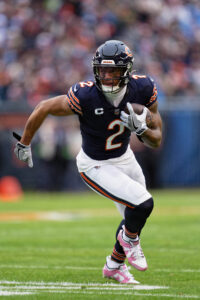 Moore, 27, said he did not shoot for a Justin Jefferson-level payday; the seventh-year player still did very well. Moore’s total guarantee number ($82.6MM) trails only Jefferson and A.J. Brown — as if we needed even more components impacting Brandon Aiyuk‘s endless 49ers negotiations — and the Bears structured this contract like a team that has a rookie QB deal around which to build. Moore’s cap number jumps from $7.2MM to $24.9MM from 2024-25, and this through-2029 contract — two seasons remained on his 2022 Panthers extension — does not include any void years.
Moore, 27, said he did not shoot for a Justin Jefferson-level payday; the seventh-year player still did very well. Moore’s total guarantee number ($82.6MM) trails only Jefferson and A.J. Brown — as if we needed even more components impacting Brandon Aiyuk‘s endless 49ers negotiations — and the Bears structured this contract like a team that has a rookie QB deal around which to build. Moore’s cap number jumps from $7.2MM to $24.9MM from 2024-25, and this through-2029 contract — two seasons remained on his 2022 Panthers extension — does not include any void years.
The Bears guaranteed Moore’s 2024 and ’25 base salaries but have some flexibility beyond that. Moore’s age and production history should make this $27.5MM-per-year deal a win for the Bears, who secured four more seasons of control and would only be on the hook for prorated signing bonus money if they moved on post-2025. Seeing as Moore is a rare No. 1 wide receiver to stop through Chicago, any departure rumors can be tabled into the late 2020s. The Maryland alum’s deal will overlap with Williams and Rome Odunze‘s rookie contracts for at least three years.
More than four months earlier, the Bears reached a quick resolution with Johnson. They did so despite allowing Johnson’s camp to negotiate with other teams at the 2023 trade deadline. The Bears were not satisfied with any trade offers, wanting a first- or second-round pick for a player who had not shown All-Pro-level form from 2020-22. Interest from multiple teams ensued, but Poles soon affirmed he wanted Johnson in the fold long term.
The Bears and Chiefs snapped a notable drought of cornerback franchise tags; the Rams’ second Trumaine Johnson tag (2017) represented the most recent such move coming into this offseason. While the Chiefs tagged L’Jarius Sneed to fetch draft capital in a trade — as the NFL’s latest dynasty operates around one-contract CBs — the Bears had more room to pay their tagged cover man.
 Poles has made his stamp on this defense, having now given high-end contracts to defenders on all three levels. The third-year GM paid Tremaine Edmunds and Montez Sweat last year and re-upped Johnson days before free agency. Johnson had expressed some frustration Sweat was paid first despite his midseason arrival and mentioned an aim at becoming the NFL’s highest-paid corner. The Bears did not give in there, but the former second-round pick — after a well-timed breakout — did well in terms of guarantees.
Poles has made his stamp on this defense, having now given high-end contracts to defenders on all three levels. The third-year GM paid Tremaine Edmunds and Montez Sweat last year and re-upped Johnson days before free agency. Johnson had expressed some frustration Sweat was paid first despite his midseason arrival and mentioned an aim at becoming the NFL’s highest-paid corner. The Bears did not give in there, but the former second-round pick — after a well-timed breakout — did well in terms of guarantees.
After subsequent deals for Sneed, Tyson Campbell and AJ Terrell, Johnson’s AAV sits 10th among corners. It is a bit unusual for a franchise-tagged player to settle for such placement, but Johnson secured $43.8MM fully guaranteed — fourth among corners — and $54MM guaranteed in total (seventh). This is also a clean contract, with no void years involved and the former second-round pick’s 2026 guarantee not vesting until that year. Johnson’s 2024 and ’25 base salaries are guaranteed; the fifth-year CB is due $44MM in that span. That is more than two tags would have covered, explaining how the Bears finalized this deal so quickly.
Pro Football Focus graded Johnson first overall among corners, and Pro-Football-Reference’s coverage metrics backed that up. After allowing passer ratings (as the closest defender) north of 94.0 from 2020-22, Johnson checked in with a 50.9 number last season — a four-INT slate that produced a second-team All-Pro honor. The Bears are confident this was not merely a contract-year outlier; they will count on Johnson to anchor their mid-2020s secondaries.
Trades:
- Acquired conditional 2025 sixth-round pick from Steelers in exchange for QB Justin Fields
- Sent Chargers No. 110 for WR Keenan Allen
- Landed DE Darrell Taylor from Seahawks for 2025 sixth-round pick
- Obtained OL Ryan Bates from Bills for No. 144
- Acquired DT Chris Williams, 2025 seventh-rounder from Browns for 2025 sixth
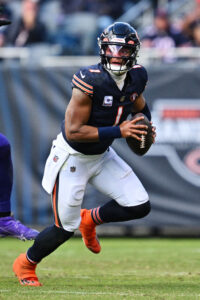 Although feigned debate surfaced about this decision, those in the league never seemed to be convinced the Bears strongly considered passing on Williams to keep Fields. The Bears wanted a Day 2 pick for their three-year starter, a player around whom they themed the 2023 trade (which moved them out of C.J. Stroud/Bryce Young territory), and the Falcons were floated as a possibility. The Fields market turned out to be ice cold. If now-starter Russell Wilson can hold off the younger passer and play 50% of the Steelers’ 2024 snaps, the Bears will only collect a 2025 sixth. Fields reaching the 51% play-time barrier would give Chicago Pittsburgh’s 2025 fourth.
Although feigned debate surfaced about this decision, those in the league never seemed to be convinced the Bears strongly considered passing on Williams to keep Fields. The Bears wanted a Day 2 pick for their three-year starter, a player around whom they themed the 2023 trade (which moved them out of C.J. Stroud/Bryce Young territory), and the Falcons were floated as a possibility. The Fields market turned out to be ice cold. If now-starter Russell Wilson can hold off the younger passer and play 50% of the Steelers’ 2024 snaps, the Bears will only collect a 2025 sixth. Fields reaching the 51% play-time barrier would give Chicago Pittsburgh’s 2025 fourth.
Poles, of course, did not draft Fields. That would have made it borderline insane had the third-year GM passed on a second straight No. 1 overall pick. The Panthers throwing Young into a terrible spot became the Bears’ golden ticket, with Chicago benefiting from the lowest point in Carolina’s history.
Poles labeled Fields’ murky status exiting the season a unique situation, and the Bears were then tied to wanting a historic haul for the top pick. No real noise about Fields having a shot to stick in the Windy City emerged henceforth, and while the Bears may or may not have passed on other offers to do right by the former No. 11 pick, it is hard to believe they rejected a significantly superior proposal. The four other teams to discuss Fields with the Bears viewed him as a backup.
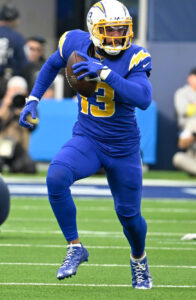 That said, Fields (23rd in 2023 QBR) would probably still be the Bears’ quarterback had Young elevated the Panthers out of the NFL basement. Though, the Bears landing the Nos. 2 or 3 picks via the Panthers may still have resulted in them dealing Fields and starting over with Jayden Daniels or Drake Maye. Fortunately for Poles, his decision proved easier. The Steelers passed on Fields’ fifth-year option, and the electric runner/sack-prone passer will not be extended in 2024. Fields looks to have a shot at sticking with the Steelers via a 2025 re-signing, but he will need to overtake Wilson and show growth.
That said, Fields (23rd in 2023 QBR) would probably still be the Bears’ quarterback had Young elevated the Panthers out of the NFL basement. Though, the Bears landing the Nos. 2 or 3 picks via the Panthers may still have resulted in them dealing Fields and starting over with Jayden Daniels or Drake Maye. Fortunately for Poles, his decision proved easier. The Steelers passed on Fields’ fifth-year option, and the electric runner/sack-prone passer will not be extended in 2024. Fields looks to have a shot at sticking with the Steelers via a 2025 re-signing, but he will need to overtake Wilson and show growth.
One of this era’s premier route-running technicians, Allen joins the Bears ahead of his age-32 season. The Bears landed the 11-year Charger despite interest from the Texans and Jets emerging; those teams circled back to other vets, while Allen began a contract year in Chicago.
The new Bolts regime offered Allen an extension, but the receiver’s camp labeled the proposal a pay cut. Allen remains tied to the $20MM-per-year deal he signed in 2020, and while he is open to an extension, the Bears now have Moore and Odunze signed long term. Even with Williams on a rookie deal, the team paying Allen even midlevel money beyond 2024 would be somewhat difficult. After all, the team has also paid a running back (D’Andre Swift) and tight end (Cole Kmet).
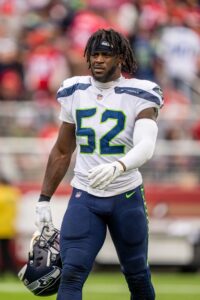 Allen is a six-time Pro Bowler who has excelled in the slot and on the perimeter. A strong Bears season could vault the former third-rounder from the Hall of Very Good tier to a player with a viable Canton case. As it stands, Williams will have one of the game’s best separators — ESPN’s Open Score metric placed Allen first in 2023 — to target in Year 1. Allen showed scant decline signs last season, averaging a career-best 95.6 yards per game and surpassing 1,200 for just the second time in a season. He got there in 13 games. The Bears will hope to extract one more prime-level year from the aging talent.
Allen is a six-time Pro Bowler who has excelled in the slot and on the perimeter. A strong Bears season could vault the former third-rounder from the Hall of Very Good tier to a player with a viable Canton case. As it stands, Williams will have one of the game’s best separators — ESPN’s Open Score metric placed Allen first in 2023 — to target in Year 1. Allen showed scant decline signs last season, averaging a career-best 95.6 yards per game and surpassing 1,200 for just the second time in a season. He got there in 13 games. The Bears will hope to extract one more prime-level year from the aging talent.
Bates remains on the Bears-built contract from 2022, when the Bills matched an offer sheet early in Poles’ GM tenure. The Bills used Bates as a 2022 starter but demoted him to a full-time backup last season. Bates, 27, battled Coleman Shelton for the center job but has missed time due to an undisclosed injury. Bates looks like the Bears’ sixth man up front when he recovers.
Taylor flashed in Seattle, posting 9.5 sacks and forcing four fumbles in 2022. He also totaled at least 5.5 sacks in each of his three healthy seasons. The former second-rounder, due for unrestricted free agency in 2025, has a chance to boost his value as a Montez Sweat sidekick.
Free agency additions:
- D’Andre Swift, RB. Three years, $24MM ($14MM guaranteed)
- Kevin Byard, S. Two years, $15MM ($7.39MM guaranteed)
- Gerald Everett, TE. Two years, $12MM ($6.06MM guaranteed)
- Coleman Shelton, C. One year, $3MM ($1.75MM guaranteed)
- Jonathan Owens, S. Two years, $3.8MM ($1MM guaranteed)
- Jacob Martin, DE. One year, $1.29MM ($668K guaranteed)
- DeAndre Carter, WR. One year, $1.2MM ($450K guaranteed)
- Matt Pryor, OL. One year, $1.18MM ($50K guaranteed)
- Scott Daly, LS. Practice squad
The Bears joined the Eagles, Texans and others in entering the Saquon Barkley sweepstakes, and while Giants GM Joe Schoen indicated on Hard Knocks that Chicago had driven up the two-time Pro Bowler’s price, it looked to be a Philly negotiation that defined the running back market’s early hours. The Eagles were looking into re-signing Swift but saw his price point move past their comfort zone, and they pivoted to Barkley, whom Howie Roseman‘s team clearly viewed on a higher tier. Swift became the 2024 UFA market’s first commit, as the Bears continued to load up a roster around another rookie-scale QB contract.
 Familiar with Swift from his Lions days, the Bears gave him the second-most money among UFA backs this year. Swift’s $14MM guarantee at signing outflanked Josh Jacobs, Derrick Henry, Devin Singletary and Aaron Jones. The ex-Detroit second-rounder’s age (25) and lighter workload by comparison to the other available backs undoubtedly boosted his stock. Swift will begin his Bears tenure with 788 career touches. Injuries were an issue for the Georgia alum in Detroit, which fetched barely a fourth-rounder in a 2023 trade.
Familiar with Swift from his Lions days, the Bears gave him the second-most money among UFA backs this year. Swift’s $14MM guarantee at signing outflanked Josh Jacobs, Derrick Henry, Devin Singletary and Aaron Jones. The ex-Detroit second-rounder’s age (25) and lighter workload by comparison to the other available backs undoubtedly boosted his stock. Swift will begin his Bears tenure with 788 career touches. Injuries were an issue for the Georgia alum in Detroit, which fetched barely a fourth-rounder in a 2023 trade.
Swift stayed healthy in Philly, booking a Pro Bowl nod after 1,049-yard rushing season. The former No. 35 overall pick also has two seasons (2020, ’22) in which he ranked in the top 10 among RBs in yards per catch, with the Lions using him as more of a dual threat compared to the Eagles. The Bears figure to take advantage of Swift’s multipurpose skillset, with the upper-middle-class RB contract pairing with Khalil Herbert and Roschon Johnson‘s rookie deals.
Byard joins Swift in coming from Philly, though the Eagles had cut the former All-Pro. Considering what happened on the safety market this offseason, Byard did well. As fellow cap casualties Quandre Diggs, Jamal Adams, Marcus Maye and Eddie Jackson all took one-year deals worth less than $4MM, Byard saw his guarantee approach where Justin Simmons‘ market went. The four-time All-Pro scored $7.5MM guaranteed from the Falcons. Byard, 31, has two first-team All-Pro distinctions on his resume (2017, 2021) and will provide a cheaper solution to Jackson’s Ryan Pace-authorized extension. Despite Byard’s involvement in the Eagles’ late-season collapse, Pro Football Focus rated him 22nd among safeties last year.
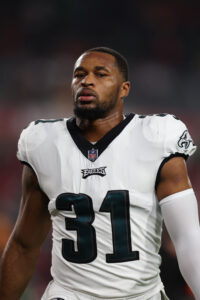 Bates may have been the early favorite to win the Bears’ center job. While the ex-Bills blocker may resurface, his recent injury looks to seal the competition for Shelton. The former Rams UDFA did not generate too much interest in free agency. The Rams had wanted to retain Shelton, but they made much bigger investments (re-signing Kevin Dotson, adding Jonah Jackson) that ended up moving Steve Avila to center and sending their incumbent elsewhere. Shelton started every Rams game last season and can use his age-29 campaign to either make a case as a multiyear Bears snapper or raise his 2025 free agency stock. PFF slotted Shelton 17th among centers in 2023.
Bates may have been the early favorite to win the Bears’ center job. While the ex-Bills blocker may resurface, his recent injury looks to seal the competition for Shelton. The former Rams UDFA did not generate too much interest in free agency. The Rams had wanted to retain Shelton, but they made much bigger investments (re-signing Kevin Dotson, adding Jonah Jackson) that ended up moving Steve Avila to center and sending their incumbent elsewhere. Shelton started every Rams game last season and can use his age-29 campaign to either make a case as a multiyear Bears snapper or raise his 2025 free agency stock. PFF slotted Shelton 17th among centers in 2023.
In addition to securing Simone Biles cameos via Owens, the Bears brought another Everett-Shane Waldron reunion. Everett spent the past two years as a Justin Herbert auxiliary target, but from 2017-21, he played under Waldron with the Rams and Seahawks. The former second-round pick has been a serviceable tight end. The receiving option, who snared the game-winning TD in 2018’s Chiefs-Rams Monday Night Football classic, has eclipsed 400 receiving yards four times as a pro. Everett teamed with Tyler Higbee in Los Angeles and Will Dissly in Seattle. Looking to have a familiar role planned for the 30-year-old talent, the Bears have yet another veteran pass catcher in place to help Williams.
Re-signings:
- Patrick Scales, LS. One year, $1.38MM ($1.15MM guaranteed)
- Marcedes Lewis, TE. One year, $2MM ($1MM guaranteed)
Drafted in the same class as 2024 Hall of Famer Devin Hester, Lewis will become the first pure tight end in NFL history to play either an age-40 season or an 19th NFL campaign. He is back in Chicago despite the Bears changing offensive staffs. Lewis will be tasked with helping Chicago’s O-line clear space for Swift and Co. The 2006 first-round pick logged 332 offensive snaps last season. While Waldron will have some receiving options at tight end, PFF ranked Lewis fifth at the position in run blocking. The Bears will have some work to do in making sure they get enough use out of Lewis and Everett.
The Bears’ longest-tenured player by a wide margin, Scales needs back surgery and is on IR with a return designation. Daly, who snapped for the Lions from 2021-23, is aboard as a replacement.
Notable losses:
- Dan Feeney, OL
- D’Onta Foreman, RB
- Trenton Gill, P (waived)
- Rasheem Green, DE
- Eddie Jackson, S (released)
- Justin Jones, DT
- Darnell Mooney, WR
- Yannick Ngakoue, DE
- Lucas Patrick, OL
- Nathan Peterman, QB
- Equanimeous St. Brown, WR
- Trent Taylor, WR
- Robert Tonyan, TE
- Cody Whitehair, OL (released)
Two more Pace-era bastions, Jackson and Whitehair, were shown the door to create cap space. Jackson spent seven seasons in Chicago, Whitehair eight. Both were successful Pace picks, each booking at least one Pro Bowl honor and starting for the two Matt Nagy playoff teams. A 2018 All-Pro, Jackson helped that Vic Fangio-coordinated defense lead the league. Whitehair started 118 games in Chicago, playing guard and center, but was benched last season. The Bears saved more than $21MM by releasing the veterans; Whitehair and Jackson respectively caught on with the Raiders and Ravens.
 A few rumors about a Bears-Ngakoue reunion emerged this offseason, with the most recent coming earlier this month. Chicago instead traded for Taylor, who comes cheaper than where Ngakoue likely views his market.
A few rumors about a Bears-Ngakoue reunion emerged this offseason, with the most recent coming earlier this month. Chicago instead traded for Taylor, who comes cheaper than where Ngakoue likely views his market.
The Bears gave Ngakoue a one-year, $10MM deal in 2023, and the nomadic edge rusher saw his seven-year streak of eight-plus-sack seasons end. The former Jaguars, Vikings, Ravens, Raiders and Colts sack artist totaled four (and just seven QB hits) before suffering a broken ankle. Ngakoue probably will catch on somewhere soon, but the 29-year-old defender may be waiting for an injury to shake up a team’s depth chart.
Mooney did not seem to fit in Luke Getsy‘s offense, as he followed up a 1,000-yard year in Nagy’s finale to combining for 907 from 2022-23. While miscast as a Bears top option in 2022, Mooney still commanded a market that also may have been indicative of the league’s view of Fields. The Falcons needed to match the Jags’ Gabe Davis deal (three years, $39MM) to land Mooney, giving Kirk Cousins a deep threat opposite Drake London. The Bears have upgraded their receiving corps significantly, however, with the draft being the second part of that effort.
Draft:
- Round 1: No. 1 (from Panthers): Caleb Williams (QB, USC) (signed)
- Round 1, No. 9: Rome Odunze (WR, Washington) (signed)
- Round 3, No. 75: Kiran Amegadjie (T, Yale) (signed)
- Round 4, No. 122 (from Eagles): Tory Taylor (P, Iowa) (signed)
- Round 5: No. 144 (reacquired from Bills): Austin Booker (EDGE, Kansas) (signed)
This draft featured six first-round QBs, but in the weeks leading up to the event, only five came up in rumors pertaining to landing spots. While a rumor about the Raiders pursuing the No. 1 pick emerged — potentially to reunite Antonio Pierce with Jayden Daniels, which came up a lot this offseason — the Bears mostly coasted to the pre-draft finish line. Williams had long been the runaway favorite to go No. 1, with his 2023 statistical step back not as notable as the regression Drake Maye saw.
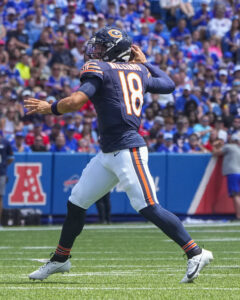 Williams still operated with high efficiency, finishing with 30 TD passes and five INTs; his 9.4 yards per attempt was better than his Heisman-year mark (9.1). USC losing five of its final six regular-season games generated more scrutiny on a player who was benefiting from NIL cash and under a spotlight that comes from being viewed as the consensus top prospect.
Williams still operated with high efficiency, finishing with 30 TD passes and five INTs; his 9.4 yards per attempt was better than his Heisman-year mark (9.1). USC losing five of its final six regular-season games generated more scrutiny on a player who was benefiting from NIL cash and under a spotlight that comes from being viewed as the consensus top prospect.
Rumors about Williams’ Combine interviews being “just OK” came out, but the Bears viewed a wide gap between Williams and this draft’s other QBs. The three-year Lincoln Riley starter has looked the part during Bears summer work. That came after an interesting attempt to secure a no-franchise tag clause in his rookie contract failed.
Chicago’s menacing defense carried Rex Grossman to a Super Bowl — in a down NFC year — while Jay Cutler went 1-for-8 in playoff appearances as a starter. Each was preferable to the infamy Mitch Trubisky caused (due to another QB that came off the board in 2017), and Fields’ passing issues undercut his run-game brilliance. The Bears have been starved here since Jim McMahon injury trouble sidetracked a would-be 1980s dynasty. They now have at least three years of Williams on a rookie-scale deal. Considering Poles had already begun to build around Fields’ rookie contract, the team has a rare opportunity to keep paying veterans to help its developing quarterback.
The Bears were high on Odunze from the start. Poles attempted to trade up one spot (via the Falcons) but did not end up needing to do so. The Jets were believed to be targeting Odunze as well, but their trade-up efforts did not succeed. The Odunze pick also came after Poles divided his front office staff into pods to debate whether to select a receiver, defensive end or tackle in Round 1. The receiver camp won out, and Odunze is on track to start alongside Moore and Allen.
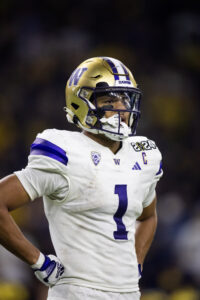 Coming off two 1,000-yard seasons in Ryan Grubb‘s Washington offense, Odunze powered the Huskies to the national championship game. The 216-pound target compiled 10 100-yard games, including a 125-yard showing to down Texas in the CFP semis, and led Division I-FBS with 1,640 yards.
Coming off two 1,000-yard seasons in Ryan Grubb‘s Washington offense, Odunze powered the Huskies to the national championship game. The 216-pound target compiled 10 100-yard games, including a 125-yard showing to down Texas in the CFP semis, and led Division I-FBS with 1,640 yards.
This may well be the best receiving corps in Bears history. The Brandon Marshall–Alshon Jeffery overlap probably wins out right now, but Allen’s track record and Odunze’s potential bring a floor-ceiling combination to pair with Moore’s consistency. Odunze holds the key to unlocking the group’s full potential, and the Pac-12 standout will likely lead other Bears nuclei at receiver during his Windy City career.
Booker flashed during preseason play, and Taylor’s arrival quickly prompted the Bears to cut two-year incumbent Trenton Gill. Amegadjie came off the active/NFI list in mid-August, rehabbing a torn quad. He profiles as a developmental piece for a Bears team, having played guard and tackle in the Ivy League.
Other:
- Fired offensive coordinator Luke Getsy; named Shane Waldron as replacement
- Hired Bills defensive line coach Eric Washington as DC; Matt Eberflus to keep play-calling reins
- Added ex-Panthers OC Thomas Brown as pass-game coordinator
- Assistant GM Ian Cunningham named finalist for Commanders GM job, signed Bears extension
- Offered third-round pick for Patriots OLB Matt Judon
- G Teven Jenkins pursued extension; moved WR Velus Jones to RB
 It can be argued Getsy was not supplied with necessary pieces to succeed; that certainly was the case in 2022. Moore’s arrival helped, and Fields made some progress as a passer in 2023. The Bears ranked 18th in scoring offense last season and 22nd in DVOA, with the Tyson Bagent stretch hurting those numbers. With Eberflus hot-seat rumors circulating, he cut the cord on his two-year OC. The Seahawks then let Waldron make a lateral move, not blocking any contracted assistants due to Pete Carroll‘s ouster.
It can be argued Getsy was not supplied with necessary pieces to succeed; that certainly was the case in 2022. Moore’s arrival helped, and Fields made some progress as a passer in 2023. The Bears ranked 18th in scoring offense last season and 22nd in DVOA, with the Tyson Bagent stretch hurting those numbers. With Eberflus hot-seat rumors circulating, he cut the cord on his two-year OC. The Seahawks then let Waldron make a lateral move, not blocking any contracted assistants due to Pete Carroll‘s ouster.
Ex-Seahawks QBs coach Dave Canales has received much of the credit for Geno Smith‘s surprising re-emergence, but Waldron called the plays in Seattle throughout his tenure. Smith led the NFL in completion percentage in 2022, setting a Seahawks passing yardage record that year as well. Seattle’s offense declined a bit last year, dropping from ninth to 17th in scoring and 13th to 21st in yardage, but Waldron (45) also met with the Patriots and Saints about their play-calling gigs. He also comes from the NFL’s most popular active coaching tree, having worked under Sean McVay for four years.
Washington, 54, spent four years on Sean McDermott‘s Bills staff. The veteran assistant also worked with McDermott in Carolina. This is Washington’s second shot at a DC post, having been named to the Panthers’ position in 2018. That tenure ended poorly, with David Tepper firing Ron Rivera and Washington’s defense ending the year 31st in Luke Kuechly‘s final season. Washington’s previous Carolina unit ranked 19th in scoring, and the Bills have continued to crank out top-five defenses despite regular personnel losses. Eberflus, however, will remain Chicago’s play-caller after taking the reins upon Alan Williams‘ abrupt early-season exit.
 Like Jaylon Johnson last year, Jenkins has expressed interest in a long-term Bears deal. The organization, which has only one notable expense on its O-line (Nate Davis‘ four-year, $40MM deal), is sitting tight for now. The Bears have seen Jenkins shift from a shaky tackle to a promising guard, but they are not planning to enter serious negotiations until at least their Week 7 bye. Poles allowed Johnson’s agent to seek a trade as negotiations stalled midway through last season; it will be interesting to see if the Bears can hammer out a deal with Jenkins.
Like Jaylon Johnson last year, Jenkins has expressed interest in a long-term Bears deal. The organization, which has only one notable expense on its O-line (Nate Davis‘ four-year, $40MM deal), is sitting tight for now. The Bears have seen Jenkins shift from a shaky tackle to a promising guard, but they are not planning to enter serious negotiations until at least their Week 7 bye. Poles allowed Johnson’s agent to seek a trade as negotiations stalled midway through last season; it will be interesting to see if the Bears can hammer out a deal with Jenkins.
During a rare non-human interest story-like reveal during Hard Knocks‘ training camp edition, Poles said he wanted to have a contract in place with Judon before agreeing to acquire him. Receiving third-round offers from the Bears and Falcons, the Patriots gave Judon a choice on what team he wanted to join. Contract matters may have been a sticking point, as the veteran edge rusher has oddly gone from an extension-seeking Patriot to a player not seemingly too eager for a Falcons deal. Atlanta does hold exclusive negotiating rights with Judon until March, but a disconnect between he and the Bears may have provided the difference. As it stands, the Bears will need contributions from multiple young DEs opposite Sweat.
Top 10 cap charges for 2024:
- Montez Sweat, DE: $25.09MM
- Keenan Allen, WR: $23.1MM
- Tremaine Edmunds, LB: $22.44MM
- Jaylon Johnson, CB: $13MM
- Cole Kmet, TE: $11.6MM
- Nate Davis, G: $11.35MM
- DeMarcus Walker, DE: $8.67MM
- T.J. Edwards, LB: $7.5MM
- D.J. Moore, WR: $7.2MM
- Caleb Williams, QB: $7.18MM
The Bears are building around a first-round QB for the third time since 2017. Considering the team joined the Panthers in passing on Stroud last year, it faces pressure for Williams to finally be the franchise QB it has pined for over the past few decades. Williams’ arrival coincides with Jordan Love‘s Packers extension and the Lions’ rise around Brad Holmes‘ core. Williams injecting life into the Bears’ operation would not only boost Eberflus’ hopes of sticking around beyond Year 3, it would make the NFC North — long an Aaron Rodgers-controlled division that featured occasional Bears or Vikings spurts — rather captivating.
Chicago’s mid-2000s defensive nucleus notwithstanding, the team has not assembled a steady contender since Mike Ditka‘s departure. Williams’ arrival, along with this rare roster-building opportunity that sees Poles’ Fields pieces shift to another rookie’s supporting cast, gives the Bears hope on this front. This season does not need to necessarily produce a Super Bowl contender for it to be deemed a success, but Williams making immediate strides would vault the Bears into a must-follow operation in the NFC’s big picture entering 2025.
Bears still suck!
You tell em’! lol
I used to work for Montgomery Wards. They had a store in Green Bay. When I finally got enough seniority I refused to go there. But when they made me go I made sure i crapped at various points in the city. Not in the washroom, Actually on the ground in the city. So if you are still looking to solve the mystery of who crapped on your town around 40 years ago, Mystery Solved. And if I had to go there again, I’d do it again. And I’m older now so it happens way more often. You’re welcome.
And the winner of the “way too much information” award goes to….lol.
No the reply fits the comment. Besides, The statute of limitations ran out 33 years ago. Although Green Bay is probably the Backwards kind of place where they would keep crap in a bag for 40 years.
@ Unclemike
I’m just worried that your comment might trigger a do-do war between these division rivals. The Packers may have already sent a pooper squad to Chicago in retaliation. Just to be on the safe side I suggest you start wearing Wellington boots 🙂
I’ve been a Bears fans far too long to buy into the hype and overblown optimism that occasionally embraces the team. My bold prediction is that they will at least be more entertaining to watch than the White Sox.
That won’t be hard. Watching paint dry is more entertaining than watching the White Sucks.
I hate the Bears. Most of my friends from school are Bears fans. (I went to Roosevelt). I have enjoyed beating the bears butts for decades as a Packers fan who grew up in Wisconsin.
I am 43 and can remember the 1987 season. For the first time since then, the Bears have a solid QB prospect. Bears fans getting excited about Fields, Trubs, Cutty, Cade McNown, Sexy Rexy, Hell even Jim Harbagh… It was cute.
This QB can play, and they’ve done a good job building the team around him too. If they don’t “Bears it up” (and there is a significant possibility that still happens because…Bears), they’re going to be a wild card threat this year and be fighting the Packers for the division for years to come.
I still think the Packers will be better long term because they’re simply a better run franchise, even now. But giving the Bears any amount of credit makes me feel ill.
I hope you suck this year, Chicago. lol
They will be better. Warren is letting Poles run the show and even though I don’t agree with some of his decisions (keeping Ebeflus), he has given a first round QB a seriously talented support group of WRs,TEs and RBs. I’ll believe in the O-line when I see it hold up.. and they’re thin at defensive tackle. But they’re gonna be competitive. To what level remains to be seen.
As a lifelong Bear fan, I hate the Packers like I hate snow in April. But they have a great HC in Lafleur and a young QB that buys what he’s selling… Still
I hope they go winless!! Cheers! Ha!
I still remember Charles Martin taking Jim McMahon and being spiked on his neck 2 minutes after the play was over and basically costing the Bears a few more Super Bowl chances. I wished him dead. Thankfully it came true. Mostly the way I feel about the Packers. Hopefully history doesn’t repeat itself. Packers Suck.
I’ve always enjoyed the rivalry and the fans for both teams always get fired up for the matches. Packers fans like Bearmeat can rant all they want but the last time I checked Chicago had 37 HOF members to Green Bays 33. That’s not bad for a franchise that “sucks”.
In 1922, Halas saved the Packers from oblivion, then in 1956 apparently helped the Packers get funding for a new stadium. You’re welcome, Packer fans